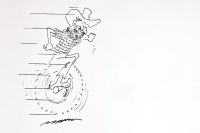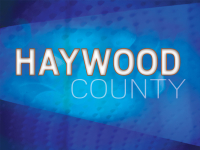Bryson City and Sylva aim to make in-town navigation easier
Plenty of green is popping up in Bryson City, but it’s not all due to the growing season. Green wayfinding signs now scattered throughout town point to landmarks ranging from the Road to Nowhere to the Swain County Courthouse. It’s the culmination of a year-long project to make in-town navigation easier and streets more attractive.
“One of the biggest things is it gets rid of the clutter,” said Brad Walker, chairman of the Swain County Tourism Development Authority. “You had all these signs pointing different directions, different sizes, and it didn’t look good. This is one way to improve the look of the city.”
It’s not an improvement that comes cheaply, though. The TDA provided $17,500 to design, produce and install the 25 signs, relying heavily on help from volunteers and collaboration from the Swain County Chamber of Commerce and N.C. Department of Transportation. It took 10 months to take the idea, which the group HandMade in America suggested after its 2011 community assessment of Bryson City, from concept to reality. The process required permission from the town and from the DOT, designing the signs, planning their locations and then actually ordering and installing the finished products. The project still isn’t fully completed — over the next month the DOT will remove the now-superfluous montage of green, blue and brown signs from city streetsides.
“It takes quite a bit of time,” Walker said.
That’s something that Paige Roberson, Sylva town manager, has also discovered. The town has been working on its own wayfinding signs since 2011, when it received a $9,000-grant for that purpose from Jackson County. The town formed a wayfinding planning committee, which used a good chunk of the grant to identify where signs were needed and what should go on them. The project is still a work in progress.
Related Items
“Our next step is identifying locations,” Roberson said. “The committee suggested several locations where they would like signs to go, but I need help boiling that down with the DOT as to where a sign can actually go.”
The DOT has specific rules regarding a sign’s reflectivity, distance from other signs and amount of text. Roberson now has to look at the committee’s suggestions and determine how best to make them jive with DOT requirements.
For the Bryson City project, planners simply took the signs already in existence — identifying schools, the hospital, visitor center, county buildings, and other landmarks — and combined that information into a more uniform system. Sylva is taking a different approach, focusing on directions to activities, such as shopping or dining, in an effort to be more tourism-centric.
“It’s a promotional tool,” Roberson said. “It makes it easier for them to be directed to the location. If they get there, it’s more likely they will see things along the way and contribute to the local economy.”
For Walker, the main point is to gather navigational information that had been scattered across multiple signs at multiple locations into one, cohesive system. The Bryson City signs don’t include categories such as shopping or dining, focusing instead on specific places.
“It reduces the clutter,” Walker said. “There’s more clarity to it.”
Bryson City currently boasts 25 dark green signs on decorative poles. For now, they appear amid the tangle of blue, green and brown signs already in existence, but over the next month the TDA and chamber of commerce will work with DOT to get rid of the extras.
Sylva, however, is still some distance away from seeing a wayfinding system on its streets. First, it will take some time to turn the committee’s suggestions into a plan that meets DOT regulations. For example, the DOT allows only three lines of text on each sign, and many of the committee’s 16 planned signs exceed that quota. That means the information will either have to be broken up into more signs or some locations will have to be taken out.
Then, there’s the cost. A 2010 proposal the town received pegged signs at $450 each, with $6,500 for production and design and $1,800 for a sign plan. Those numbers are likely different four years later, but with just $4,780 left in the grant, Roberson said, installation might be a piecemeal project.
“I think it would be better to do in phases than a large amount of money all at once,” Roberson said.
The end result, she hopes, will be a navigation system that helps tourists while supporting locally-owned businesses that can’t pay the high fees required for highway advertising.
Meanwhile, Bryson City’s wayfinding signs are entering their inaugural tourist season.
“They’re very nice,” Walker said. “I’m happy with them.”









